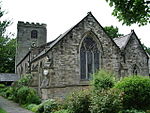St Luke's Church, Slyne with Hest
Austin and Paley buildingsChurch of England church buildings in LancashireChurches completed in 1900Churches in the City of LancasterDiocese of Blackburn ... and 4 more
Gothic Revival architecture in LancashireGothic Revival church buildings in EnglandGrade II listed churches in LancashireUse British English from September 2013

St Luke's Church is in Manor Lane, Slyne-with-Hest, Lancaster, Lancashire, England. It is an active Anglican parish church in the deanery of Tunstall, the archdeaconry of Lancaster, and the diocese of Blackburn. Its benefice is united with those of St Saviour, Aughton, and St Wilfrid, Halton. The church is recorded in the National Heritage List for England as a designated Grade II listed building.
Excerpt from the Wikipedia article St Luke's Church, Slyne with Hest (License: CC BY-SA 3.0, Authors, Images).St Luke's Church, Slyne with Hest
Shady Lane, Lancaster Slyne-with-Hest
Geographical coordinates (GPS) Address External links Nearby Places Show on map
Geographical coordinates (GPS)
| Latitude | Longitude |
|---|---|
| N 54.0877 ° | E -2.8055 ° |
Address
St Luke's Church
Shady Lane
LA2 6JD Lancaster, Slyne-with-Hest
England, United Kingdom
Open on Google Maps









